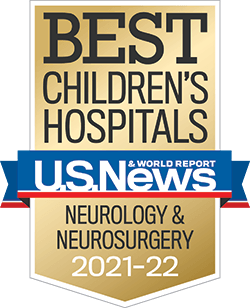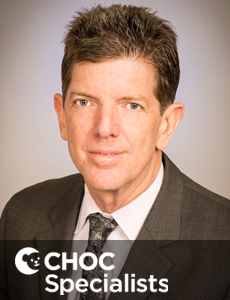Free 24/7 Nurse Advice Line: 844-GET-CHOC.
Chiari Malformation
When you hear that your child may need brain surgery due to a Chiari malformation, you may feel overwhelmed. Our neurosurgery team is highly trained in children’s brain disorders, and we will be with your family from diagnosis throughout your child’s growth to ensure the best possible outcome.
What is a Chiari malformation?
A Chiari malformation is a condition where brain tissue squeezes through an opening, at the base of a child’s skull, into the spinal canal. This puts pressure on the brain and spinal cord, causing symptoms with a variety of severity. A chiari malformation occurs because of improper development that causes the skull to be misshapen (malformed) or too small. A chiari malformation is a congenital condition, meaning it is present at birth, although symptoms may not present until adolescence or young adulthood.
What are the types of Chiari malformations in children?
There are two Chiari malformation types that are classified based on the severity of the symptoms and the parts of the brain that extend into the spinal canal.
Chiari malformation Type I (CM-I)
The most common type of Chiari malformation, Chiari I malformation, occurs when the cerebellum extends into the canal opening. Type I is most often congenital, which means it is present at birth, but usually doesn’t present symptoms until adolescence or young adulthood. Chiari malformation type I could potentially lead to other health problems like long-term pain, a pocket of spinal fluid (syrinx) in the spinal cord or brain stem, life-long damage to muscles or nerves, not being able to move your arms or legs because the muscles no longer work (paralysis).
Chiari malformation Type II (CM-II, Arnold Chiari malformation)
Chiari II, also known as classic Chiari malformation or Arnold Chiari malformation, occurs when the cerebellum and possibly the brainstem bulge through the opening at the base of the skull into the spinal canal. Chiari II malformation is also congenital, and it is seen with spina bifida. Treatment includes surgery to ease symptoms and/or stop the progression of damage to the nervous system. For most people, surgery improves or stabilizes symptoms. Some people may require more than one surgery.
What causes Chiari malformations?
An acquired Chiari malformation type I happens to a person after birth. It is caused by extra leaking of spinal fluid from the lower back (lumbar) or chest (thoracic) areas of the spine. This can happen because of an injury, contact with harmful substances or an infection.
Medical experts do not know what causes congenital malformations, or those present at birth. They think that something happens to the fetus while it is growing that causes the brain to form abnormally.
What are the symptoms of Chiari malformations?
Chiari Malformation Type I Symptoms
The most common symptom of Chiari malformation type I is headaches that cause pain in the back of the head or neck. The pain may become worse with laughing, sneezing or coughing. Other symptoms of CM-I include:
- Hoarseness or trouble speaking
- Trouble swallowing
- Rapid, back-and-forth eye movements (nystagmus)
- Periods of not breathing during sleep (sleep apnea)
- Weakness; abnormal movements or reflexes
- Trouble with balance
- Scoliosis (curvature of the spine)
Chiari Malformation Type II Symptoms
Chiari II malformations are typically diagnosed in newborns or infants. This is due to the severity and the fact that other defects may require additional screening, revealing the malformation. Other symptoms of CM-II include:
- Spina bifida
- Spinal myelomeningocele (part of the spinal cord and backbone develop outside the body)
- Noisy breathing
- Trouble swallowing
- Problems with breathing food or fluid into the lungs (aspiration)
- Short periods of not breathing (apnea)
- Weakness in the arms
Additional symptoms in older infants and children may include:
- Hydrocephalus that gets worse over time
- Scoliosis
- Vision problems or hearing loss
- Trouble with motor skills in their hands
With any type of Chiari malformation, an additional condition called a syrinx—a collection of spinal fluid in the spinal cord—might occur, triggering other symptoms like weakness, numbness and bowel problems.
What are the treatment options for a Chiari malformation?
At first, your doctor may recommend careful watching and medication to soothe the pain and headaches. However, decompression surgery may be the most effective way to alleviate the pain and minimize the risks of additional complications that arise from Chiari malformations and related conditions. Children who experience sleep issues, such as sleep apnea, may also need a sleep study to learn about potential other treatments.
Chiari Malformation Surgery
The surgery to treat Chiari malformations is called posterior fossa decompression, or sometimes just Chiari decompression. It involves removing a part of the occipital bone at the base of the skull through a small incision that is made on the back of the head. This allows more space for the cerebellum and brainstem, and lessens pressure on the brain and spinal cord.
If necessary, the surgeon will also open the dura, the protective covering around the brain and spinal cord, to allow for more free space. A graft (replacement tissue) is used to expand the dura, similar to letting out the waistband on a pair of pants.
The surgery lasts about two hours, and recovery time varies depending on the age of the patient and other factors. In most cases, surgery completely resolves the pain and discomfort of a Chiari malformation.
Our board-certified surgeons have experience from the most routine to rare surgical procedures. Whether your child has a Chiari malformation or multiple conditions requiring several operations, our team will work with your family to ensure you are informed, prepared and comfortable from pre-surgery through recovery.
When to Seek Help for a Chiari Malformation
If you notice any changes in your child’s ability to breathe, swallow, feed, speak, walk or move, call your health care provider. In older children, a headache that worsens with sneezing, coughing or laughing may indicate a problem.
Why CHOC? A team of experts in Chiari Malformation
As a parent, your first priority is choosing a hospital and team of doctors who can provide the best outcome for your child and your family. The CHOC Neuroscience Institute is a place dedicated to caring for kids with complex and rare medical issues. Our specialists have devoted their training, research and practice to caring specifically for children.
- The pediatric neurosurgeons at CHOC have extensive experience treating all types of Chiari malformations, performing dozens of Chiari decompressions each year. Our doctors have the expertise and experience to operate with confidence, using the most advanced techniques to ensure your child enjoys long-term, symptom-free health.
- We practice a team approach to healing. Neurological conditions in children require a team of caregivers including neurologists, orthopedic specialists, nurses, social workers, rehabilitation therapists and more. Our team works together on every aspect of your child’s care from diagnostics to surgery and follow-up care.
- We care about your child deeply, and will care for the whole family. We make the experience seamless, and that includes coordinating care, communicating with your child’s primary care physician, and discussing your child’s treatment with your family as long as you need to get all of your questions answered. CHOC is here for you.
- We understand that a hospital can seem overwhelming for both the child and their family. Our child life specialists work with families to “normalize” hospital equipment and procedures so you can concentrate on healing instead.
- Our surgical center is outfitted with advanced imaging, communication and robotics technologies, specific to children and their needs. This ensures a high level of proficiency and safety for the children under our care.

Meet Our Pediatric Neurosurgeons

Olaya, Joffre E. MD
Specialty:
Neurosurgery
Appointments: 714-509-7070
Dr. Joffre Olaya specializes in neurosurgery. He sees kids and teens at CHOC Hospital in Orange and CHOC at Mission Hospital.

Muhonen, Michael G. MD
Specialty:
Neurosurgery
Appointments: 714-509-7070
Dr. Michael Muhonen is a board certified neurosurgeon at CHOC, treating babies, kids and teens with neurological disorders.

Loudon, William G. MD, PhD
Specialty:
Neurosurgery
Appointments: 714-509-7070
Dr. William Loudon is a board-certified pediatric neurosurgeon at CHOC Hospital.











